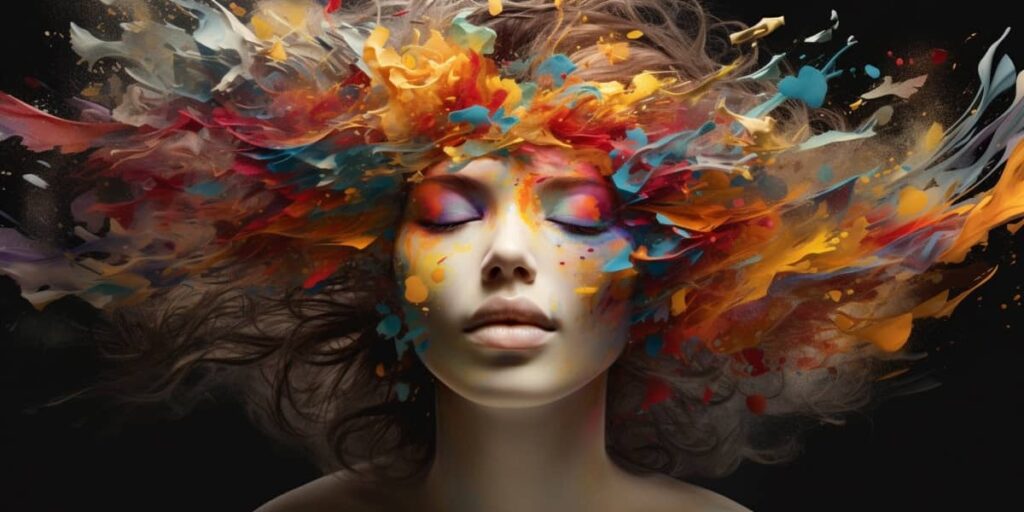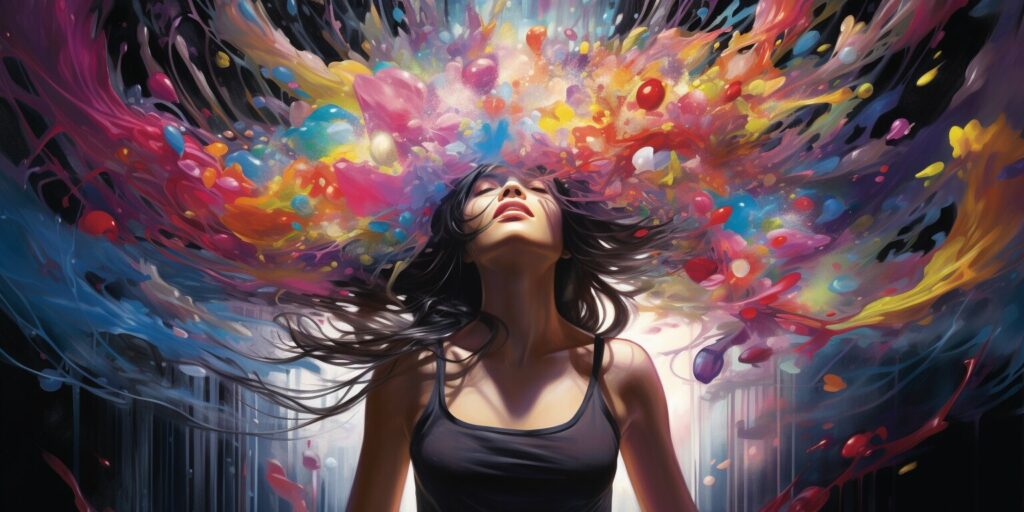Imagine living in a world where numbers have colors, or a word said aloud triggers the taste of strawberries. For those with synesthesia, this isn’t just imagination – it’s their reality. Synesthesia is a fascinating neurological condition that links one sensory experience to another, creating unique personal perceptions for individuals who experience it.
There are numerous types of this intriguing phenomenon, each offering its own kaleidoscope of sensory experiences. Some folks see musical notes as vibrant colors dancing before their eyes; others might feel specific textures when tasting certain foods. It’s an extraordinary blend of senses that stretches our understanding of human perception.
In this post, I’ll delve into the various types of synesthesia and how they can influence an individual’s interaction with the world around them. From grapheme-color synesthesia to auditory-tactile synesthesia, we’re about to explore some incredible cross-sensory experiences. Strap yourself in – we’re embarking on a journey through the captivating world of synesthetic sensations!
Understanding the Concept of Synesthesia
I’ve always been fascinated by synesthesia, a perceptual phenomenon where stimulation of one sense leads to involuntary experiences in another. It’s like your senses have decided to play musical chairs! For example, imagine tasting shapes or hearing colors. Sounds quite surreal, doesn’t it? Yet for individuals with synesthesia, this cross-wiring of senses is their reality.
To better understand this concept, let’s dive into the science behind it. Synesthesia is believed to be caused by increased communication between sensory regions and is often associated with hyperconnectivity in the brain. It’s interesting to note that there are as many as 80 different types of synesthesia – some people might see letters in color (grapheme-color synesthesia), while others may taste words (lexical-gustatory synesthesia).
Here are few recognized types:
- Grapheme-color Synesthesia
- Chromesthesia
- Spatial sequence Synesthsia
- Number form Synesthsia
- Ordinal linguistic personification
| Type | Description |
|---|---|
| Grapheme-color | Letters or numbers are perceived as inherently colored |
| Chromesthesia | Sounds such as music or voices trigger seen colors |
| Spatial sequence | Numbers, months of the year, and/or days of the week elicit precise locations in space |
| Number form | Numbers create mental maps |
| Ordinal linguistic personification | Ordered sequences such as ordinal numbers or alphabetical order are associated with personalities |
But what does living with synesthesia feel like? People with this condition often describe their experiences as being perfectly normal since they’ve lived with them for most if not all their life. It’s only when they realize that others don’t perceive the world in the same way do they recognize their unique ability.
Synesthetes might hear a car horn and simultaneously see a flash of red light; taste chicken soup while also feeling a cube shape in their hands. While it might seem strange to most of us, these experiences are completely natural for them.
It’s important to remember that synesthesia isn’t a disease or disorder – it doesn’t require treatment and often contributes positively to a person’s life. Many individuals with Synesthesia use their unique perceptions in their creative work, making significant contributions to art, music, and literature.
In the end, synesthesia serves as a vivid reminder of how varied and rich human perception can be. Our senses aren’t just limited pathways – they’re intricate highways capable of fascinating cross-connections!
Commonly Identified Types of Synesthesia
Diving right into the fascinating world of synesthesia, it’s clear that there are several types commonly identified by experts. Let’s start with Grapheme-Color Synesthesia, arguably the most recognized form. People with this type perceive letters and numbers as inherently colored. Imagine seeing the number ‘5’ always in pink or letter ‘A’ forever in green.
Another intriguing type is Chromesthesia, where sounds, music or voices trigger a color visualization. Some people might see Mozart’s symphony in vibrant reds and blues while others may experience their friend’s laughter as splashes of pastel yellow.
Then we have Lexical-Gustatory Synesthesia – quite a mouthful, isn’t it? Here, spoken or written language causes individuals to taste certain flavors. As bizarre as it might sound to many of us, words like ‘justice’ could taste like fresh apple pie or ‘table’ might evoke the flavor of mint ice cream for these rare folks.
Spatial Sequence Synesthesia represents yet another type – here digits, months of a year, days in a week occupy precise locations in space around an individual. For instance, if you have this type of synesthesia and someone mentions “Wednesday”, you might visualize it somewhere above your right shoulder.
Lastly but definitely not least is Mirror-Touch Synesthesia where individuals physically feel what they observe others experiencing – imagine feeling someone else’s hug or sensing their stubbed toe!
- Grapheme-Color: Letters and numbers trigger colors
- Chromesthesia: Sounds invoke visual colors
- Lexical-Gustatory: Words cause tastes
- Spatial Sequence: Sequences exist spatially
- Mirror-Touch: Feelings mimic observed experiences
These forms illustrate just how diverse synesthetic experiences can be! Yet remember that these are only some examples; the boundaries are far from definitive given how uniquely personal each person’s synesthetic experiences can be.
Grapheme-Color and Chromesthesia: Explained
Let’s dive in deep to explore the mysterious realm of synesthesia, particularly focusing on Grapheme-Color and Chromesthesia. Ever imagined how it’d be if you could see colors while listening to music or associate specific hues with particular letters or numbers? Well, that’s precisely what a person with these types of synesthesia experiences.
Grapheme-color synesthesia is one of the most common types where each letter or number triggers the visualization of a specific color. It’s like having a personal, colorful alphabet! For instance, they might always perceive ‘A’ as red or ‘3’ as green. The fascinating part is that these associations remain consistent throughout their life.
On the other hand, chromesthesia – also known as sound-to-color synesthesia – paints an individual’s world in vibrant colors based on different sounds. So when they hear a violin playing, they might visualize purple swirls dancing around them. These aren’t just random occurrences but rather consistent sensory cross-overs that add an extra layer to their auditory experience.
The exact cause behind these forms of synesthesis remains unknown but theories suggest it may stem from increased communication between sensory regions in the brain. There are even some enticing statistics associated with this phenomenon:
| Percentage | Fact |
|---|---|
| 1% | Estimated population worldwide experiencing some form of synesthesia |
| 6:1 | Ratio at which grapheme-color Synesthetes outnumbers chromesthetes |
It should be noted that for those living with these conditions, it isn’t distracting or overwhelming; instead, it’s simply a part and parcel of their everyday perception.
To further illustrate:
- Imagine seeing your favorite song painted across the sky in brilliant hues.
- Picture reading a book where every character is delicately tinted – transforming black and white pages into rainbow scripts!
So there you have it – a colorful insight into the world of Grapheme-Color and Chromesthesia synesthesia. It’s indeed a fascinating phenomenon, providing us with a vibrant glimpse into how diverse human perception can truly be.
Mirror-Touch and Lexical-Gustatory Synesthesia
Diving right into the topic, mirror-touch synesthesia is a fascinating phenomenon I’d like to explore. It’s where individuals physically feel the same sensation another person is experiencing just by observing them. Imagine watching someone get a high-five, and then you also feeling a slight sting on your palm. That’s mirror-touch synesthesia for you!
A study conducted in 2013 found that about 1.6% of the general population experiences this type of synesthesia. Let me lay out these statistics in a digestible manner:
| Year | Percentage of People with Mirror-Touch Synesthesia |
|---|---|
| 2013 | 1.6% |
Moving on, let’s talk about lexical-gustatory synesthesia now – an equally intriguing condition where words and phrases are experienced as tastes or even full meals! Imagine reading the word “book” and tasting apple pie; it seems bizarre but it’s exactly what happens to people who have this type of synesthesia.
Interestingly, according to research done in 2006:
- Most lexical-gustatory synesthetes are male
- The most common flavors reported were those associated with sweet foods
Here’s how it breaks down:
| Fact | Detail |
|---|---|
| Dominant gender among synesthetes | Male |
| Most commonly associated taste category | Sweet foods |
Synesthesias like these might seem peculiar to many of us, but they’re part of everyday life for those who experience them! Remember, our understanding of such phenomena continues to grow as researchers delve deeper into these sensory crossovers.
Less Common but Fascinating Types of Synesthesia
Delving deeper into the world of synesthesia, I’ve uncovered some less common types that are truly fascinating. Let’s dive in and explore these intriguing variations.
Mirror-touch synesthesia is one such variant that’s sure to pique your curiosity. Imagine feeling a touch on your own body when you see someone else being touched. Sounds unreal, right? Yet, for those with mirror-touch synesthesia, it’s their everyday reality!
Now let’s talk about lexical-gustatory synesthesia – a mouthful to say and even more so to experience! In this unique type, words or phonetics trigger taste sensations. Consider tasting chocolate whenever you hear the word “book”, or experiencing a tangy flavor every time someone mentions “time”. Unusual? Absolutely! But also incredibly captivating.
On we move to ordinal-linguistic personification (OLP), where ordered sequences like numbers, days of the week, or months evoke personalities or genders. Picture Monday as an assertive female leader while Tuesday comes across as a timid young boy!
Ordinal-linguistic personification isn’t alone in attributing human characteristics; object-personality synesthesia does this too – but with objects instead of sequences! An individual with this type might perceive their desk as stubborn or their lamp as friendly.
While these forms are less prevalent than grapheme-color or chromesthia (sound-to-color), they’re equally enthralling and contribute significantly to our understanding of sensory perception and brain function.
Aren’t these lesser-known types truly startling? While they’re not something most people can relate to directly, recognizing them expands our grasp on how intricate and diverse human sensory experiences can be.
Impact of Different Synesthesias on Daily Life
Living with synesthesia can be both a blessing and a challenge. Synesthetes, or individuals who experience this phenomenon, perceive the world in unique ways that often intertwine senses. For example, they might see colors when they hear music, or taste flavors when they read words.
One type of synesthesia is Grapheme-color synesthesia. It’s where letters or numbers are perceived as inherently colored. Imagine reading a book, not just in black and white text but with each letter dancing in different hues. Sounds fascinating, right? But it can also be overwhelming especially during tasks like data analysis where numbers are involved.
Chromesthesia is another interesting form. Here, sounds typically evoke the perception of color and shape. So you’d think listening to Beethoven would be an entirely new concert for these individuals – seeing symphonies painted across their vision! On the downside? Noisy environments could turn into chaotic color explosions.
Mirror-touch synesthesia is a rarer form where individuals feel the same sensation that another person feels. If they see someone being touched on their arm, they feel a touch on their own arm! This could lead to empathy overload which might affect social interactions negatively.
Lastly we have Lexical-gustatory synesthesia – tasting words quite literally! Each word brings up sensations of taste making conversations quite ‘flavorful’. However eating while talking might be an issue if your “how do you do” tastes like pickles!
Synesthetes do have daily life adaptations though:
- Using memory aids: The additional sensory perceptions act as bonus memory pegs.
- Seeking solitude: To avoid sensory overload.
- Choosing professions wisely: Artists & musicians frequently report having some form of Synesthesia!
So yes, living with Synesthesia isn’t easy peasy but it certainly paints an extraordinary picture of life!
Scientific Research and Studies on Synesthesia Types
Diving into the realm of synesthesia, I’ll guide you through the fascinating findings from scientific research and studies. It’s quite an intriguing phenomenon with numerous types to explore. Let’s start by understanding that not all synesthetes experience this condition in the same way – the variations are truly astounding.
There’ve been several notable scientific studies conducted over the years. A classic example comes from a study published in Nature Neuroscience, where researchers found that synesthetic experiences could be induced by hypnosis in non-synesthetes, suggesting our brains may be inherently capable of such sensory cross-talk.
But let’s put some numbers to words:
| Study | Year | Key Findings |
|---|---|---|
| Nature Neuroscience | 2005 | Synesthetic experiences can be induced in non-synesthetes via hypnosis |
| Neuropsychologia journal | 2013 | Synesthesia might be related to an unusually high number of connections between neurons |
Another significant study published in 2013 in Neuropsychologia suggested that synesthesia might result from an unusually high number of connections between neurons. This connection surplus could explain why a letter or number triggers a color perception for grapheme-color synesthetes.
A further remarkable finding comes from another research done at University College London which indicated people with face-color synesthesia (where faces trigger color perceptions) were better at recognizing faces than average people – even faces they’d only seen briefly!
Here are some more key points garnered from various scientific studies:
- Certain forms of synesthesia are more common than others.
- Some individuals can have more than one type of synesthesia.
- The exact cause remains unknown but it’s thought genetics play a role.
Though we’ve just scratched the surface here, it’s clear how complex and diverse this phenomenon is! From inducing experiences via hypnosis to linking neuron connectivity with this condition, the scientific exploration of synesthesia is far from over. We’re continually learning more about this fascinating neurocognitive phenomenon and who knows what new insights tomorrow’s research might bring?
Conclusive Thoughts on the Spectrum of Synesthesia
Reflecting on the subject, it’s clear that synesthesia is a fascinating phenomenon. This unique sensory experience varies greatly from person to person, with some individuals experiencing colors when they hear sounds, while others might taste words or associate numbers with specific personalities.
Let’s remember that there are over 60 reported types of synesthesia and each one presents its own unique blend of sensations. From grapheme-color, where numbers or letters trigger color perceptions, to lexical-gustatory, where certain words evoke tastes, the spectrum is incredibly diverse.
No two synesthetes share an identical experience which makes this condition all the more intriguing. As our understanding continues to evolve, we’re learning just how complex and multifaceted our human sensory system truly is.
Research into synesthesia has opened up new pathways in neuroscience and psychology. It challenges traditional ideas about perception and sensation – encouraging us scientists to reconsider what we thought we knew about the brain.
The world of synesthesia proves there’s so much more left for us to discover about human cognition and sensory perception. As I continue my exploration into this captivating topic, I’m excited by the potential for future research directions.
So here’s my final thought: Whether you’re a researcher delving into the intricacies of cross-modal perception or simply someone intrigued by our mind’s limitless capabilities – keep questioning, keep exploring. In doing so, you’ll find that every discovery brings us closer to understanding what makes us uniquely human.
To summarize:
- Synesthesia is a wide-ranging phenomenon with over 60 reported types.
- Each type offers a unique blend of sensations.
- Research into this area challenges traditional views on sensation and perception.
- There’s still much left to learn about our cognitive processes through studying synesthesia.



